전선의 외부 층에 절연체가 있을 것입니다.. 주요재료는 5가지, 즉 PVC, 체육, 푸르, TPE, 및 TPU. This article mainly introduces the characteristics of these five materials.
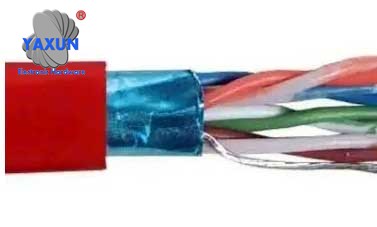
호일 쉴드가 있는 PVC, 4 쌍 꼬인 26AWG
1. PVC material
Category 6, PVC, with foil shield, 4 twisted pairs, 26AWG
Definition: It is a particle prepared by mixing, kneading and extruding polyvinyl chloride as the base resin, adding stabilizers, plasticizers, calcium carbonate and other inorganic fillers, auxiliaries and lubricants.
Pros: Can be formulated to work in a variety of environments and applications. It is low cost to use, flexible, fairly strong, and has fire/oil repellent properties.
Disadvantages: Low-end PVC materials contain harmful substances and may be unstable when used in special environments. 현재, the PVC material has also been upgraded to enhance environmental protection elements and improve performance.
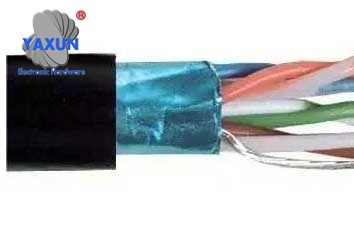
Category 6e shielded outdoor cable, PE sheath, 23AWG
2. PE material
Category 6e shielded outdoor grade direct buried cable, PE sheath, 23AWG solid
Definition: Polyethylene material, this one is also very common. The linear molecular structure of polyethylene makes it highly susceptible to deformation at high temperatures. 그러므로, in the application of PE in the wire and cable industry, polyethylene is often cross-linked into a mesh structure, making it highly resistant to deformation even at high temperatures.
Advantages: more environmentally friendly, generally such products have passed the EU’s ROHS environmental pollution test. It has excellent electrical insulation properties and good processing properties.
Disadvantages: Average weather resistance, not suitable for high temperature environments.
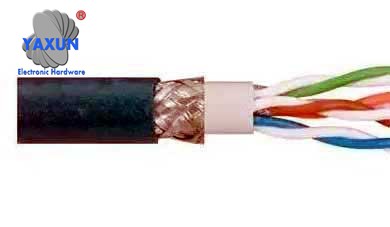
Category 5e, PUR jacket, 4 pairs of 26 AWG stranded conductors
3. PUR material
Category 5e, ultra-flexible PUR jacket, shielded, 4 pairs of 26 AWG stranded conductors
Definition: Polyurethane (푸르) is a polymer with repeating structural units of urethane segments made by the reaction of isocyanate and polyol.
Advantages: Excellent oil resistance, good toughness, wear resistance, cold resistance (low temperature resistance), water resistance, aging resistance, acid and alkali resistance, weather resistance, long service life, UV resistance and many excellent functions. Suitable for harsh occasions such as oil pollution and low temperature environment.
Disadvantages: It has many functions, so the price will naturally be slightly higher. Compared with PVC materials, the cost will be much higher.
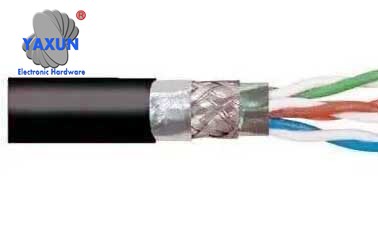
Category 5e SF, UTP cable, CMX flame retardant 24AWG
4. TPE/TPR material
Category 5e SF/UTP cable, highly flexible CMX flame-retardant TPE sheath, 4 pairs of 24AWG multi-stranded wires
Definition: TPE (Thermoplastic Elastomer) thermoplastic elastomer, sometimes also called TPR (Thermoplastic Rubber), that is, thermoplastic rubber.
Advantages: It has good chemical resistance and oil resistance, is very flexible, and has better wear resistance.
Disadvantages: Not very strong, nor resistant to high temperatures, and usually cannot be used in environments above 80°C for a long time.
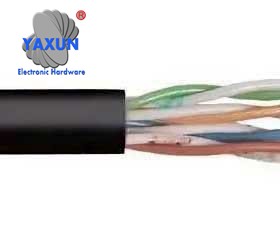
TPU material cable
5. TPU material
Definition: Generally called polyurethane material, it is thermoplastic polyurethane elastomer rubber.
Advantages: Mainly divided into polyester type and polyether type, hardness range (60HA-85HD). Wear-resistant, oil-resistant, transparent and elastic, TPU not only has excellent properties of high wear-resistance, high tension, high pulling force, strength and aging resistance, but is also a mature environmentally friendly material.
Disadvantages: Slightly lacking in sturdiness and easily deformed.
 English
English العربية
العربية Български
Български 中文(漢字)
中文(漢字) Čeština
Čeština Dansk
Dansk Eesti keel
Eesti keel Suomi
Suomi Français
Français Deutsch
Deutsch Ελληνικά
Ελληνικά עברית
עברית Magyar
Magyar Bahasa Indonesia
Bahasa Indonesia Italiano
Italiano 日本語
日本語 한국어
한국어 Latīna
Latīna Latviešu valoda
Latviešu valoda Lëtzebuergesch
Lëtzebuergesch Polski
Polski Português
Português Română
Română Русский
Русский Slovenščina
Slovenščina Español
Español Svenska
Svenska ภาษาไทย
ภาษาไทย Tiếng Việt
Tiếng Việt
